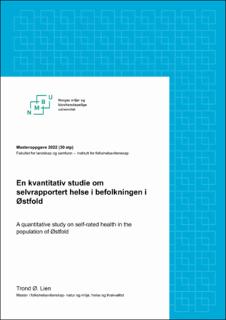| dc.contributor.advisor | Ihlebæk, Camilla Martha | |
| dc.contributor.author | Lien, Trond Østlien | |
| dc.coverage.spatial | Norway, Østfold | en_US |
| dc.date.accessioned | 2022-07-12T13:10:36Z | |
| dc.date.available | 2022-07-12T13:10:36Z | |
| dc.date.issued | 2022 | |
| dc.identifier.uri | https://hdl.handle.net/11250/3004688 | |
| dc.description.abstract | Bakgrunn
Selvrapportert helse (SRH) er et hyppig benyttet mål på subjektiv helse når man skal kartlegge folkehelse og den vanligste måten å måle dette på er ved spørsmålet «Hvordan vurderer du alt i alt din egen helse?». Forskning har vist at SRH er en god prediktor for hvordan det går med folk i løpet av livet i forhold til ulike helserelaterte mål. Men det er fortsatt manglende kunnskap om hva SRH egentlig måler og hvilke faktorer som er assosiert med hvordan folk vurderer og rapporterer sin SRH.
Formål
Å undersøke sammenhengen mellom sosiodemografi, livsstilsfaktorer, psykiske og fysiske plager, sosial kapital og SHR i et representativt utvalg av den voksne befolkningen i Østfold.
Metode
Et kvantitativt tverrsnittsdesign ble benyttet og er basert på et analytiskutvalg på N=12 804 respondenter i alderen 18 til 79 år bosatt i Østfold. En trinnvis logistisk regresjonsanalyse ble benyttet for å se på hvordan de ulike variablene sosiodemografi, livsstil, psykiske og fysiske plager og sosial kapital var assosiert med det å rapportere god SRH.
Resultater
Det var 72 % av det analytiske utvalget som rapporterte god SRH. De faktorene som bidro sterkest til å forklare variansen i SRH var sosiodemografiske faktorer og psykiske plager og fysiske plager. De sosiodemografiske variablene i blokk 1 forklarte 24% av variansen i SRH og den sterkeste sammenhengen ble funnet for det å være sysselsatt som økte odds med 9 ganger for å rapportere god SRH sammenlignet med det å ikke være sysselsatt. Når livsstilsvariabler ble lagt til i modellen økte forklart varians bare til 28 %, men når variablene for psykiske og fysiske plager ble lagt til i blokk 3 forklarte modellen hele 46% av variansen i SRH. Variablene for sosial kapital bidro også signifikant, men bidro bare til å øke forklart varians i SRH til 47%.
Konklusjon
Resultatene i denne studien viste at alle de fire hovedgruppene av helsedeterminanter var signifikant assosiert med l SRH, selv om de i ulik grad bidro til å forklare variansen i SRH. Disse resultatene viser betydningen av å ha en bred tilnærming når man vil fremme god helse i befolkningen. Det helsefremmende arbeidet bør spesielt ha søkelys på økt sysselsetting og andre tiltak som hindrer at sosioøkonomiske faktorer skaper sosial ulikhet i helse. Tiltak mot psykiske lidelser og bedring av helse og livskvalitet for personer med kronisk sykdom er også viktig for den generelle folkehelsen i lys av disse resultatene. | en_US |
| dc.description.abstract | Background
Self-rated health (SRH) is a frequently used tool to measure subjective health when the aim is to get knowledge about the general health of a population. The most common question used to measure SRH is “In general, would you say your health is”. Studies have shown that SRH is a good way to measure how people are doing during their lifetime relative to various health related issues. There is still a lack of knowledge about what SRH is measuring and what factors are associated with how people are considering and reporting SRH.
Aim
To investigate the relationship between socio demography, lifestyle factors, mental and physical problems, social capital, and SRH in a representative selection of the adult population of Østfold.
Method
The method used was a quantitative cross- sectional study based on an analytical selection of 12 804 respondents between the ages 18- and 79-years old living in Østfold. A step-by-step logistic regression analysis was utilized to investigate how sociodemographic factors, lifestyle factors, mental and physical problems and social capital was associated with good SRH.
Results
72% of the individuals in the analytical sample reported good SRH. The strongest contributors to the variance in SRH were socioeconomic factors, mental illness, and chronic disease. The sociodemographic variables in block 1 explained 24% of the variance in SRH and the strongest association was found in being employed where the odds of reporting good SRH was 9 times higher compared with the non-employed group. When adding the lifestyle variables to the model the variance increased only to 28%. After adding the variables of mental illness and chronic disease in block 3 the model explained 46% of the variance in SRH. The variables of social capital also contributed significantly, but only increased the variance in SRH to 47%.
Conclusion
The results of this study showed that all four main groups of health determinants were significantly associated with SRH even though their contribution in explaining the variance in SRH varied between the groups. These results show that health promotion needs to have a broad perspective and aim at several health determinants simultaneously to be successful. An increased focus on employment and measures to counteract social economic factors from creating social inequality in health is encouraged. These results also show that measures directed towards mental illness and increased health and wellbeing for people with chronic disease also are important factors in public health. | en_US |
| dc.language.iso | nob | en_US |
| dc.publisher | Norwegian University of Life Sciences, Ås | en_US |
| dc.rights | Attribution-NonCommercial-NoDerivatives 4.0 Internasjonal | * |
| dc.rights.uri | http://creativecommons.org/licenses/by-nc-nd/4.0/deed.no | * |
| dc.title | En kvantitativ studie om selvrapportert helse i befolkningen i Østfold | en_US |
| dc.title.alternative | A quantitative study on self-rated health in the population of Østfold | en_US |
| dc.type | Master thesis | en_US |
| dc.description.localcode | M-FOL | en_US |

